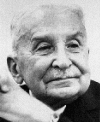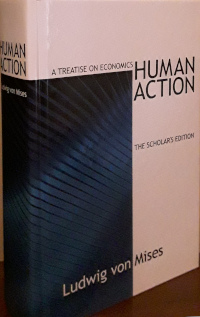
When Ludwig von Mises died in New York City in 1973 at the age of 92, there was no front-page obituary in the New York Times. But believers in liberty knew that a giant had fallen.
In the intellectually stimulating atmosphere of the University of Vienna, the young Mises studied in the tradition of the founder of the Austrian School of economics, Carl Menger. Mises also attended the seminar of the other giant of the School, Eugen von Böhm-Bawerk.
After receiving his PhD, Mises set to work on The Theory of Money and Credit (1912), his first major work. The earlier Austrians had followed the classical school in separating money from the rest of the economy, analyzing it in separate theoretical terms. Mises argued that just as the price of any commodity is determined by supply and demand, so is the purchasing power of money, its "price."
The publication of The Theory of Money and Credit gained the 31-year old Mises a Europe-wide reputation. But World War I brought a new intellectual atmosphere much less conducive to a man like Mises. The war ended the gold standard, strengthened central banking, and put an end to a century of free markets.
Seen as holding unfashionable and outdated views, he was never to receive the academic rewards that were his due.
In Socialism—published in 1922, and now hailed as the classic that predicted the breakdown of the communist experiment—he argued that socialism could not function in an industrial economy because there would be no market for capital goods and therefore no price system to calculate profit and loss.
During the 1920s Mises saw a quickening of interest in his ideas in Europe, and he was one of the few to predict the Great Depression. In the early 1930s, many important economists became Misesians, but after John Maynard Keynes's General Theory swept the academic world, many of his followers defected to Keynesianism.
Undaunted and in exile in Geneva from the National Socialists, Mises wrote his monumental Nationalökonomie, published in 1940 but forgotten in the turmoil of World War II. This work was later expanded and translated into English as the 900-page Human Action (1949), his crowning achievement.

In 1940, Mises and his wife Margit emigrated to the United States. At a time when every communist and social democratic exile from Europe was given a high academic post in the United States, Mises was refused a job. But with the help of Henry Hazlitt and Lawrence Fertig, Mises secured a visiting professorship at New York University's Graduate School of Business. His salary was paid by business people and foundations, and he was never to be a regular member of the faculty.
But Mises was neither bitter nor resentful. He simply carried on the fight for Austrian economics and freedom. When he retired in 1969, at 87, he was the oldest active professor in the United States. He could look back on a lifetime of teaching and writing—25 books and more than 250 scholarly articles—and of many achievements for liberty.
Mises did not live to see the renewed interest in his ideas, which began with F.A. Hayek's Nobel Prize and flourished with the founding of the Mises Institute. But today the statism against which Mises fought all his life is under systematic attack. There could be no greater monument to the life and thought of an eminent and noble man.
—excerpted from The Mises Institute web site
Copyright © 2000, The Daily Objectivist - Reprinted with permission of The Daily Objectivist and Davidmbrown.com.
31 Oct 2009 (last edit: 13 Nov 2024)
You can assist the work of Freedom Circle by purchasing one of the works discussed above:
